
 Data Structure
Data Structure Networking
Networking RDBMS
RDBMS Operating System
Operating System Java
Java MS Excel
MS Excel iOS
iOS HTML
HTML CSS
CSS Android
Android Python
Python C Programming
C Programming C++
C++ C#
C# MongoDB
MongoDB MySQL
MySQL Javascript
Javascript PHP
PHP
- Selected Reading
- UPSC IAS Exams Notes
- Developer's Best Practices
- Questions and Answers
- Effective Resume Writing
- HR Interview Questions
- Computer Glossary
- Who is Who
Angles of a Parallelogram
Introduction
Angles of a parallelogram ?s sum is 360 degrees. A parallelogram has four interior angles, and the total of those interior angles is always 360°. In a parallelogram, the adjacent angles are supplementary, and the opposing angles are equal. Let's read in greater detail about the characteristics of a parallelogram's angles. Following is the geometrical figure parallelogram IJKL in which $\mathrm{IJ\:=\:LK\:}$ & $\mathrm{JK\:=\:IL}$
$$\mathrm{IJ\:\rVert\:LK\:\:,\:JK\rVert\:IL}$$
that is opposite edges are equal and parallel and diagonals are bisectors of each other they intersect at the point O. In parallelogram opposite angles are of the same measure i.e., $\mathrm{\angle\:I=\:\angle\:k}$ & $\mathrm{\angle\:J\:=\:\angle\:L}$
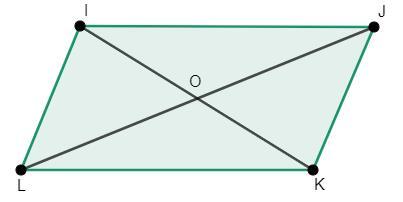
Parallelogram
Parallelogram is a quadrilateral whose pair of opposite sides are equal in length, and opposite angles are equal in measure.
Properties of parallelogram
Parallelogram is 4 sided figure
It is a polygon of 4 sides and 4 angles
In a parallelogram, opposite edges are equal in length
In parallelograms, opposite angles are equal in measure
In a parallelogram, diagonals are unequal
In a parallelogram, diagonals intersect at the common point and bisect each other at the point of intersection
In a parallelogram, two pairs of opposite sides are parallel
In a parallelogram, the alternate angle theorem and corresponding angle theorem can be applied
Properties involving Angles
In a parallelogram, the opposing angles are equal (or congruent)
The complementary angles to each other are consecutive angles (that means they add up to 180 degrees)
The parallelogram's opposite angles are equal.
The inverse of the aforementioned theorem states that a quadrilateral is a parallelogram if its opposite angles are equal.
Any consecutive angles of a parallelogram are supplementary.
A parallelogram's respective two adjacent angles added together equal 180°.
All four angles are right angles if one of them is a right angle in a parallelogram
Properties involving Sides
In Parallelogram opposite sides are congruent
A parallelogram's diagonals cut each other in half.
A parallelogram is divided into two congruent triangles by each of its diagonals.
Solved Examples
1)If two adjacent angles in a parallelogram are $\mathrm{x°}$ & $\mathrm{2x°}$ then find the measures of each angle in the parallelogram.
Answer In a parallelogram the opposite angles are equal in measure.
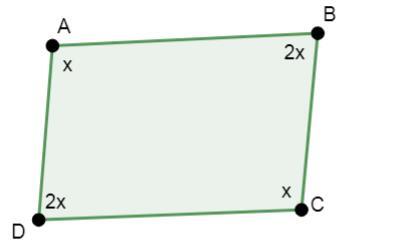
In the above figure angle A and angle B are $\mathrm{x°}$ & $\mathrm{2x°}$ respectively.
Using angle sum property of a quadrilateral we get,
$$\mathrm{x\:+\:2x\:x\:+\:2x\:=\:360}$$
$$\mathrm{6x\:=\:360}$$
$$\mathrm{x\:=\:60}$$
Thus the measure of each angle is 60° , 120° , 60°, & 120°
2)Find the measures of unknown angles in the following figure.
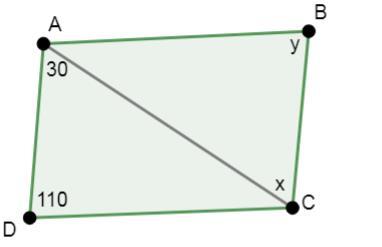
Answer
In parallelogram ABCD,$\mathrm{AB\:\rvert\:DC\:and\:AC}$ is its transversal.
Thus, pairs of alternate angles are equal in measure.
$$\mathrm{\angle\:DAC\:=\:\angle\:ACB\:\Longrightarrow\:x\:=\:30°}$$
In parallelogram, opposite angles are in equal measure.
Thus,
$$\mathrm{\angle\:ADC\:=\:angle\:ABC\:\Longrightarrow\:y\:=\:110°}$$
3)Determine the lengths of unknown sides of the following parallelogram.
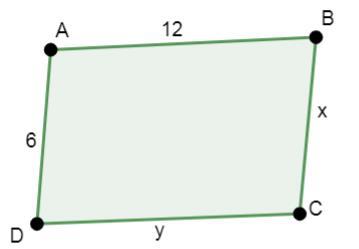
Answer In parallelogram opposite edges are the same in length.
Thus,
$$\mathrm{x\:=\:6\:\&\:y\:=\:12}$$
Thus, the lengths of unknown sides are 6 and 12 units.
4)If two adjacent angles in a parallelogram are $\mathrm{2x°\:\&\:4x°}$then find the measures of each angle in the parallelogram.
Answer In parallelogram the opposite angles are equal in measure.
Using angle sum property of a quadrilateral we get,
$$\mathrm{2x\:+\:4x\:+\:2x\:+\:4x\:=360}$$
$$\mathrm{12x\:=\:360}$$
$$\mathrm{x\:=\:30}$$
5)Determine the measure of angle ? in the following parallelogram IJKL
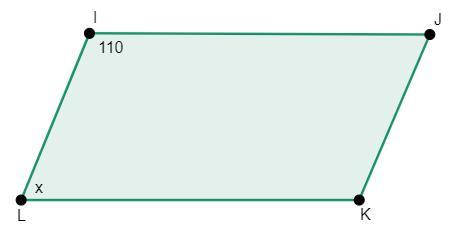
Answer
We know that opposite angles in a parallelogram are of equal measure. Thus,
$$\mathrm{\angle\:I\:=\:\angle\:K\:=\:110°\:\&\:\angle\:J\:=\:\angle\:L\:=\:x}$$
Since the sum of four angles in quadrilaterals is 360 degrees, thus
$$\mathrm{\angle\:I\:+\:\angle\:J\:+\:\angle\:K\:+\:\angle\:L\:=\:360°}$$
$$\mathrm{110\:+\:x\:+\:110\:+\:x\:=\:360°}$$
$$\mathrm{2x\:+\:220\:=\:360°}$$
$$\mathrm{2x\:=\:140}$$
$$\mathrm{x\:=\:70}$$
6)What are the most important properties of parallelograms involving angles?
Answer The following are the most important properties of parallelograms involving angles
The opposing angles of a parallelogram are equal (or congruent)
The following angles are complementary to one another (that means they add up to 180 degrees)
The diagonals of the parallelogram have identical angles.
The converse of the aforementioned theorem holds that if the angles on opposite sides of a quadrilateral are identical, it is a parallelogram.
Any parallelogram's subsequent angles are supplementary.
The sum of the two neighbouring angles of a parallelogram is 180°.
If one of the four angles is a right angle in a parallelogram, then all four are right angles.
Conclusion
As per the above discussion regarding parallelograms we can conclude the following facts about parallelograms
The shape is referred to as a rhombus if the parallelogram's sides are completely equal.
Rhombi can use the features of parallelograms as well.
When one pair of sides in a parallelogram are parallel, the shape is referred to as a trapezoid.
The parallel and nonparallel sides are referred to as bases and legs, respectively.
We have what is referred to as an isosceles trapezoid if the legs are congruent.
FAQ
1. What makes angles in a parallelogram unique?
The opposing angles line up. All of the angles will be at right angles if any one of them is a right angle. The two diagonals cut across one another.
2. Which parallelogram angle(s) have consecutive angles?
A parallelogram's neighbouring angles are often referred to as consecutive angles and are always supplementary (180°).
3. What parallelogram's angles are equal?
The internal angles of a parallelogram must be equal and opposite. The total of the four inner angles must also be equal to 180 degrees. The surrounding internal angles must also be supplementary (sum of degrees). Angles must be supplementary angles because they are next to one another.
4. Why are opposite angles in a parallelogram equal?
The squares on both diagonals are the same since the lengths of the opposing sides are identical. A quadrilateral whose diagonals cut each other in half has already been shown to be a parallelogram. ABCD has equal lengths on its opposite sides since it is a parallelogram. (Matching angles of triangles that are congruent).
5. What is the crucial property of a parallelogram?
As the name implies, a parallelogram is a straightforward quadrilateral with opposite sides that are parallel. There are two sets of parallel sides as a result. A parallelogram also has equal opposite angles and diagonals that cut through one another.
6. Are a quadrilateral's four sides equal in size?
Both regular and irregular quadrilaterals exist. A regular quadrilateral must have four equal sides, four equal angles, and diagonals that cross each other in a bisecting direction. The only quadrilateral that meets each of these requirements is the square.
7. Can there be two right angles in a parallelogram?
A quadrilateral with two sets of parallel sides is referred to as a parallelogram. The sides of these figurines are parallel to one another and have the same hue. A form having four equally long sides. The shape lacks right angles and has two sets of parallel sides.

